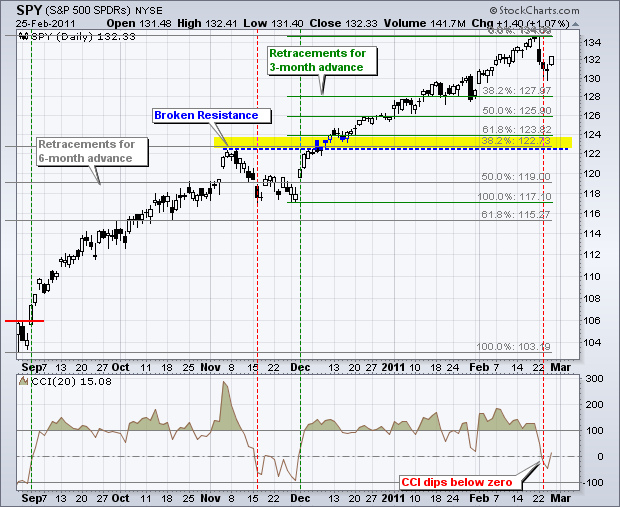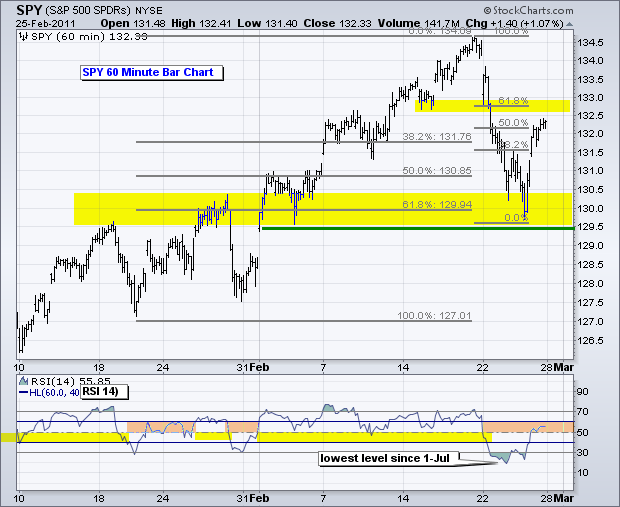On the 60-minute chart, the S&P 500 ETF (SPY) firmed at support around 130 mid-week and bounced back above 132 on Friday. The 62% retracement and broken resistance marked this support zone. In addition, SPY was oversold and overbought $VIX suggested that stocks were ripe for a mean-reversion rally. We got that rally now what? The bounce reinforces support in the 130 area and I will raise key short-term support to 129.5. While Friday's bounce and strong close were impressive, SPY is already nearing its first short-term resistance zone in the 132.5-133 area. Notice that this zone marks a 62% retracement of last week's decline and broken support (yellow area). If this rally were to fail, I would expect failure in this area. Also notice that RSI moved into the 50-60 zone, which typically marks resistance in a short-term downtrend.

Overall, the short-term evidence still favors the bulls. The medium-term trend remains up on the daily chart. Technically, the short-term trend has yet to reverse. Last week's decline was sharp, but it came from a 52-week high and stocks bounced on Friday. The bears still need to be careful. Short-term breadth statistics are mixed. The 10-day SMA for Nasdaq Net Advances ($NAAD) and Nasdaq Net Advancing Volume ($NAUD) moved below -100, but the 10-day SMAs for NYSE Net Advances ($NYAD) and NYSE Net Advancing Volume ($NYUD) remain in bull mode. These breadth indicators were also split at the end of January when the Nasdaq indicators turned bearish, but the NYSE indicator remained in bull mode. RSI turned short-term momentum bearish with a plunge below 30. Oversold readings are more likely in a short-term downtrend than a short-term uptrend. Despite Nasdaq breadth and bearish RSI, the medium-term uptrend and short-term uptrend still rule the day.


It is a pretty big week on the economic front. Chicago PMI kicks off the week on Monday. The ISM is on Tuesday and Bernanke begins his two-day testimony before congress. ISM services its on Thursday and the employment report is on Friday.
Key Economic Reports/Events:
Mon - Feb 28 - 08:30 - Personal Income & Spending
Mon – Feb 28 - 09:45 - Chicago PMI
Mon – Feb 28 - 10:00 - Pending Home Sales
Tue - Mar 01 - 10:00 - Construction Spending
Tue - Mar 01 - 10:00 - ISM Index
Tue - Mar 01 - 10:00 – Bernanke Testimony
Tue - Mar 01 - 15:00 - Auto/Truck Sales
Wed - Mar 02 - 07:00 - MBA Mortgage Index
Wed - Mar 02 - 07:30 - Challenger Job Cuts
Wed - Mar 02 - 08:15 - ADP Employment
Wed - Mar 02 - 10:00 – Bernanke Testimony
Wed - Mar 02 - 10:30 - Crude Inventories
Wed - Mar 02 - 14:00 - Fed's Beige Book
Thu - Mar 03 - 08:30 - Initial Claims
Thu - Mar 03 - 08:30 - Continuing Claims
Thu - Mar 03 - 10:00 - ISM Services
Fri - Mar 04 - 08:30 - Nonfarm Payrolls
Fri - Mar 04 - 10:00 - Factory Orders
Charts of Interest: Tuesday and Thursday in separate post.
-----------------------------------------------------------------------------
This commentary and charts-of-interest are designed to stimulate thinking. This analysis is not a recommendation to buy, sell, hold or sell short any security (stock ETF or otherwise). We all need to think for ourselves when it comes to trading our own accounts. First, it is the only way to really learn. Second, we are the only ones responsible for our decisions. Think of these charts as food for further analysis. Before making a trade, it is important to have a plan. Plan the trade and trade the plan. Among other things, this includes setting a trigger level, a target area and a stop-loss level. It is also important to plan for three possible price movements: advance, decline or sideways. Have a plan for all three scenarios BEFORE making the trade. Consider possible holding times. And finally, look at overall market conditions and sector/industry performance.







